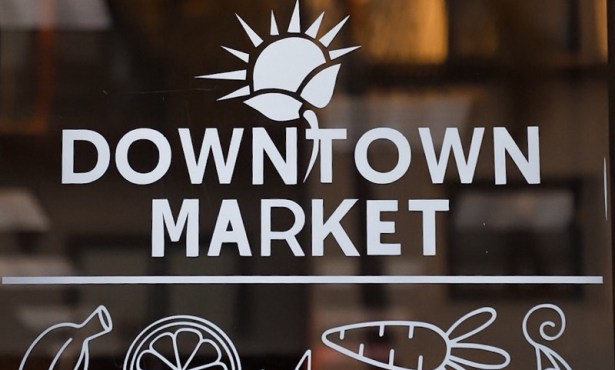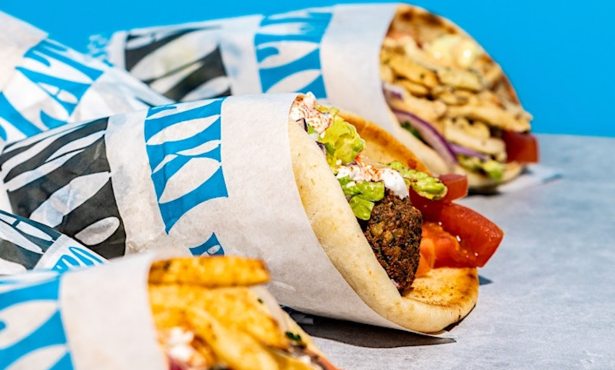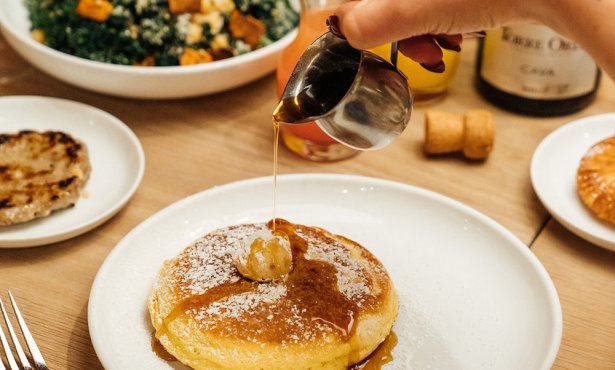From Markets to Midnights, Eating Up the Hungry Cat
New Cat on the Block
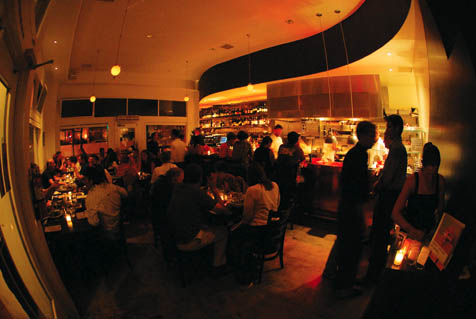
At 8:30 on Saturday morning, the three chefs and general manager of the Hungry Cat drift into the small restaurant on the corner of Anapamu and Chapala streets and brew some coffee, pouring it hot and strong into clear pint glasses and using it to chase the chunks of bright orange Charlene melon they pass around. The restaurant won’t open until 5 p.m., but today is Farmers Market day, and in a few minutes the team will pile into Chef Dylan Fultineer’s Subaru station wagon with a hand truck and drive the 10 or so blocks to what is clearly their idea of heaven-the Santa Barbara Farmers Market. It’s been fewer than six hours since Pete Destler, the general manager, locked the doors after closing on Friday night, but he looks happy. Compared to the night soon after opening-when the whole block lost power at 3 a.m. and he slept there so as to be ready when the electricity came back on-last night’s four hours of sleep at home is no big deal.
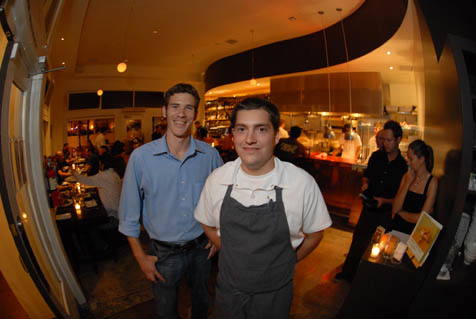
The Hungry Cat shops primarily at the Farmers Market-a common enough practice in theory, certainly one with a long and healthy tradition in Santa Barbara, but still something that only perhaps 20 percent of restaurants actually do consistently. Fewer still do so with the focus and intensity of the Hungry Cat, which is the brainchild of David Lentz and Suzanne Goin, the Los Angeles chefs behind the Hungry Cat in Hollywood, and, in the case of Goin, two of L.A.’s most celebrated restaurants, AOC and Lucques. It’s certainly much easier to accept delivery on more standard produce, and, as Lentz told me, “You do pay a premium-the idea that the Farmers Market is cheaper is a myth,” but the philosophy at work here says the extra effort is not just worth it, but is a big part of what the restaurant is all about.
Fultineer, grill chef Patrick Mullins, and sous chef Mike Coan moved here from Chicago, where they worked together at Blackbird, another hip, informal but fine-dining bistro. They are in such good spirits, despite working a grueling succession of 14-hour days, because, as Fultineer told me within the first five minutes of my meeting him, “We are so lucky! Sometimes we just look at each other and shake our heads in disbelief that we are getting the chance to do this.” With the oldest members of the team still younger than 30, the Hungry Cat presents an intriguing question. Can a team this young compete against the likes of John Downey, who’s been doing this for 25 years, or bouchon’s Josh Brown, another prodigy who may be just as young but who has experienced owner Mitchell Sjerven close at hand every night?
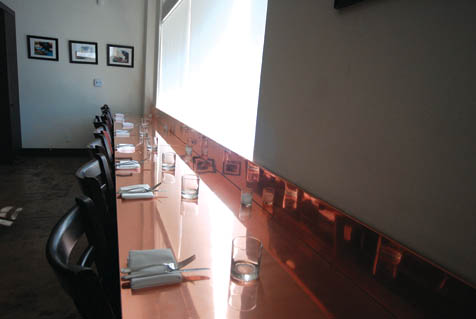
Lentz and Goin have paid the people in this crew the ultimate compliment of handing them the keys, and, standing with them before they go out shopping, it’s obvious from their energy that they know it’s the chance of a lifetime. In a cooking contest where the prize is shopping for more food, these guys feel like winners. After willingly sacrificing both sleep and fun to work long hours six nights a week in a tiny, hot kitchen, they revel in the early trip to the market, eager to chat with the farmers, while searching for exotic herbs and vegetables. As good as it feels, given the high stakes and the ultra labor-intensive course Lentz and Goin have set for them, it will be very interesting to see how they hold up.
Prodigies and the New Paradox
Seemingly from time immemorial, the gulf that divides successful chefs from anonymous kitchen help has been defined by a rigorous system of apprenticeship. Fierce hierarchies rule in the kitchens of so-called serious restaurants. New people come in at the bottom, and only gradually work their way up. While this system still exists, the explosion of interest in fresh food and competitive, physically demanding cooking has created new challenges and new opportunities in the restaurant world. A phenomenon-the prodigy chef-that was once rare has become increasingly common, and some really outrageous new wrinkles, such as the boy sommelier, have appeared. Destler tells me that Eric Railsback, the beverage manager and director of the wine program at the Hungry Cat, who’s in France now for a harvest research trip, has the best palate he’s encountered in 15 years-and Railsback is 22!
Behind all this precociousness looms a secondary phenomenon that may, in the long run, be just as important, which is that there are more and more people like Lentz and Goin with the clout, reputation, and ambition to open new restaurants where they allow these young chefs and sommeliers a chance to show their stuff. In a world where, for a long time, it felt as though the ranks were thickly settled and difficult to ascend, serious cooking suddenly looks like a career wide open to talent.
The restaurant business is deceptively simple: You buy food, fix it up, and then sell it for more than you paid for it. But, oh, the heartache that has come from this misperception! When you think about the idea that it could possibly be easy to take something as volatile as food, prepare it professionally, and then vend it (often from an expensive location) to a customer who has no incentive to return other than the quality of the product, it doesn’t sound so simple. Of all small businesses, restaurants are the most likely to fail, and most likely to do so in their first year.
So why would Lentz and Goin-two of the most sought-after personalities in America’s current fascination with chefs-bother opening a small place on a supposedly “cursed” corner in Santa Barbara? (Lentz takes the supposed curse seriously, and said, “Believe me, we burned a lot of sage.”) Add to this the fact that the couple had their first children-twins!-this year, just two weeks before the restaurant opened, and the mystery deepens.
The answer lies somewhere amid the bewildering array of signs that America’s relation with food and restaurants has undergone a fundamental shift, a shift that has, for the moment, produced something of a paradox-the informal fine-dining experience.
Meet Us at the Market
Down at the Farmers Market, Fultineer and team are making the rounds, loading up the hand truck, paying the vendors, and storing everything in an inconspicuous spot behind the stand of their favorite farmer before hauling it all out to the car. Trailing along with them, I feel as though my perception of the market has been sharpened; every time I see another hand truck, I know it’s likely to be another professional chef. Look, there’s Ashley from Duo Catering; there are the people from Square One.
As the animated conversations multiply around me, so do the morsels I am being handed to try. At first they’re familiar things, like tomatoes. Coan seems to have an eye for the tasty ones, and while we are chatting with Seth Kunin, who put up the chefs when they first moved to Santa Barbara, one of the ripe ones explodes out of Mullins’s mouth, splattering Fultineer with juice and seeds.
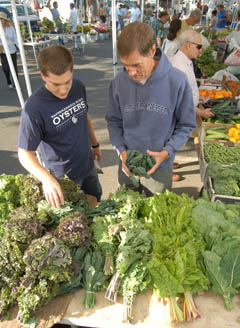
Then, moving into the herbs, things get more interesting. As we visit with BD, a dreadlocked farmer who specializes in exotic greens, Fultineer hands around tiny leaves of stevia, the super-sweet herb from Paraguay. “It’s a hundred times sweeter than sugar,” he says, as I bite down on the most intensely sweet bit of leaf I’ve ever tasted. (Virtually calorie-free, stevia has been declared an “unsafe food additive” by the FDA. With little medical evidence to back this up, some in the natural foods community suspect a conspiracy to protect the interests of companies that manufacture artificial sweeteners.)
The magic of our Farmers Market needs no explanation-it’s pretty much agreed that, along with the climate and the wine, the market is one of the things that sets us apart as an earthly paradise. In her cookbook, Sunday Suppers at Lucques, Goin intersperses the recipes with short chapters about shopping the greenmarkets of the world. Here is where we get the Hungry Cat’s philosophy about ingredients distilled into simple, vibrant prose. I especially like what Goin has to say about Meyer lemons, a backyard-garden staple here in Southern California. “Unlike regular lemons, Meyer lemons are sometimes on the soft side. Look for unblemished skin and fragrant fruit. In a perfect world, the leaves and stems would still be attached,” Goin wrote. I can’t help but remember seeing plenty of Meyers with intact leaves and stems. Does that mean a perfect world is only a lemon away?
When I mention this passage to Lentz, he counters with his favorite part of the market sections, Goin’s discussion of tomatoes, where she recommends looking for heirloom tomatoes with flaws and seams, because they are most flavorful. Somehow the process of reading between the lines here adds to the pleasure.
While Goin and Lentz may be the immediate presences directly shaping the Cat’s approach, other important figures are also close at hand. Destler is a veteran of several other fine dining establishments, both in Santa Barbara and the Napa Valley. His longest tenure in town was working alongside Liz and John Downey as an assistant manager at Downey’s, and he has nothing but great things to say about them. “In four years, I never once heard John raise his voice. That sounds like a good thing, but you have to understand that, for a serious chef in a busy kitchen, it’s more like a miracle.”
Destler also has a great story about how he got here. While working at a restaurant in upstate New York, he was serving Tim Zagat, of the famous Zagat restaurant guides. When asked if he was serious about cuisine, Destler answered in the affirmative, and Zagat said, “Go to Santa Barbara, and look up John Downey. He has his own place there, and he’s a genius.”
Destler didn’t take Zagat’s advice right away-that would be too neat a story. But, after going to the Culinary Institute of America, then coming to S.B. to work on the opening of the Bacara, and then going to Napa for another start-up in Yountville, Destler found himself looking for a way to come back to our city. That’s when he remembered what Zagat said.
Chowing the Cat
For the purposes of this next section, I want to make a disclosure. I did not have an expense account for this story, and, apart from some off-the-menu appetizers about which I will say more in a moment, I was not given any complimentary food. Instead, I paid my own way, and, during the course of a month, ate at the Hungry Cat five times. I mention this not only to clear up any ethical issues involved, but also to illustrate something of genuine importance. While the Hungry Cat is by no means inexpensive-bank-breakers include the giant raw bar platter-it is not really an expensive restaurant. A newspaper editor can eat here regularly without going broke.
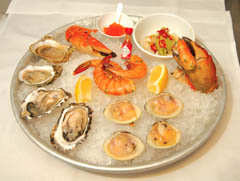
Chicago’s Blackbird under Fultineer, Coan, and Mullins had a formula something like what is at the Hungry Cat now-food you’ve rarely eaten, rendered in a style that makes you comfortable and leaves you satisfied. The Chicago Farmers Market scene was competitive, with farmers using temporary greenhouses in the off-seasons, and many in-season favorites were gone before most of the restaurants could get there. Fultineer remembers the long drive to Evanston, and the pressure of getting there before 7 a.m., when “there would literally be elbows flying to get the berries.”
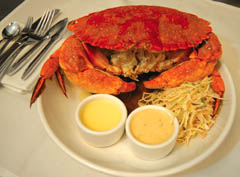
In Santa Barbara, the market may be more relaxed, but the elbows have been flying somewhere else-in the line to get into the Hungry Cat, which doesn’t take reservations. Destler takes the pressure to seat people fairly and promptly very seriously, saying that, for him, the restaurant’s reputation is on the line every time someone walks in the door. To make everyone’s life a little easier, Destler allows people to call 45 minutes ahead at busy times and put their names on the waiting list from home. While an hour or more wait for a table on Saturday night is not unknown, this system means savvy diners can spend that hour at home, fixing their makeup or having a cocktail.
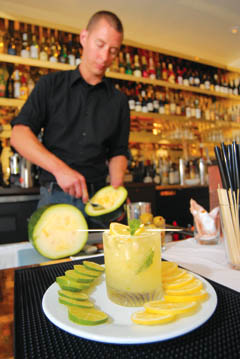
Now comes the good part. Eating at the Hungry Cat frequently begins not with wine, but with cocktails-they’re considered part of what’s cooking. Sourced from the Farmers Market like everything else, the drinks are concocted based on what’s fresh. Last week it was plums, next week it might be berries. All the drinks are made from scratch with house-made simple syrups, infusions, freshly squeezed fruit, and fresh herbs. The Pimlico is a classic, with Early Times bourbon, orange juice, lime, and mint. So is the cucumber martini, made with Hendrick’s gin, freshly juiced cucumber, and lime.
The idea behind the beverage program-designed by Eric Railsback, Lentz, and Goin, but presided over by bar manager Jessica Castillo-is that cocktails are not just something you pour from a rack, squirt with a hose, and finish with a hunk of fruit or an olive. Cocktails here are another chance to cook, another place for the constant creative ferment of invention that bubbles up out of all that Farmers Market time to find expression.
Lentz and Goin designed the original Hungry Cat in Hollywood to address a demographic they felt was underserved by the L.A. restaurant scene-themselves. Lentz said the original idea was to make a place they would want to go to, not just on special occasions, but all the time, at least once a week. Here’s how he described it: “We thought, ‘What is L.A. missing?’ How about a midrange raw bar where you can drink champagne, eat caviar, and then, you know, flow from there.”
In case it’s not obvious, these two are not your average diners; their idea of a casual night out can mean a burger (the Cat’s pug burger-with bacon, avocado, and blue cheese-is amazing), but it can also mean champagne, caviar, and whatever else “flows from there.” So, while the menu typically offers a dozen or more choices of appetizers and entrees, the night often gets started with a fruit of the sea platter, filled with the kind of things one associates with the ocean, or late nights in New York City or Paris-oysters, of course, but also clams and shrimp, lobster tail, and mussels. In Santa Barbara lately (the menu varies in both locations), we’ve been getting some great sea urchin, served in its freaky shell, to be scooped out with a spoon. So that’s often the opener-a round of cocktails or a glass of wine and a platter, sometimes with the caviar, which is all-American, sometimes without.
Typically, right now what “flows from there” is some kind of fish, especially some kind of marinated fish, as Lentz is currently fascinated by sashimi and ceviche-style preparations. There’s an appetizer that’s regularly on the menu of hamachi, the delicious, buttery fish that’s a staple of sushi bars and is also known as yellowtail, marinated in a chile-ginger vinaigrette, then tossed with sliced plums and hearts of palm.
While it would take far too long to go into all the permutations of what’s happening in Fultineer’s kitchen these days-I didn’t get through even half the menu-one entree gives a feeling for the originality here. It’s a squid salad with lima beans; the Monterey Bay squid is prepared two ways, then layered among the salsa verde sauce and a delicious savory Italian green, puntarella, that is kind of like a straight-leafed arugula. The secret to this dish is at the bottom of the plate: the big, creamy beans. While at first you are going to be preoccupied with distinguishing the contrasting flavors of the confit of tentacles and the oak-grilled tubes of the squid, eventually your fork is going to come up with a mouthful of bean that knocks you out. More flavorful than anything imaginable, the beans give the dish a starch that makes this squid salad as homey and comforting as a bowl of fresh pasta.
Home on the Line
As I finish my late meal-the kitchen is open until 10 p.m., and the restaurant is open until midnight, seven days a week-Destler sits beside me to have his, a sandwich of white sausages that one of the bartenders brought in for him to try. The staff is always playing around with new ideas; the results may not make it onto the menu, but are an important part of the process.
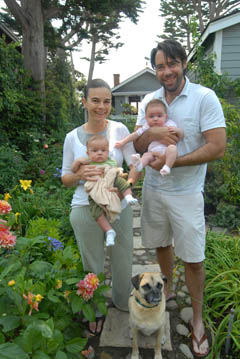
I got to try two such experiments, an amazingly delicate plate of thinly sliced giant abalone, and two fantastically delicious cooked oysters which Coan and Mullins “wood-fired,” a technique they have yet to figure out how to scale so it can be done for a roomful of customers. With the energy and creativity of youth, each night these guys come in with the desire to try something new, and to make it special. The spirit comes from the line, where everyone involved feels most at home.
On that subject, I’ll let Lentz have the last word: “I don’t like working the room. I like to cook. It’s funny, but a lot of times there’s so much going on, and I just go on the line and cook, it clears my head. It’s important to focus on something besides the issues of these multiple operations or even just the kind of typical bullshit that goes on with restaurants.”
With twins at home and so many irons in the fire, Lentz and Goin have a lot on their plates, but for now, it’s all delicious.
4•1•1
The Hungry Cat is located at 1134 Chapala Street. Call 884-4701. Dinner is served from 5 p.m.-midnight on Monday-Saturday, and from 5 p.m.-10 p.m. on Sunday. The bar is open until 1 a.m. on Monday-Saturday and until 11 p.m. on Sundays.

